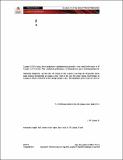Por favor, use este identificador para citar o enlazar a este item:
http://hdl.handle.net/10261/251884COMPARTIR / EXPORTAR:
 SHARE SHARE
 CORE
BASE CORE
BASE
|
|
| Visualizar otros formatos: MARC | Dublin Core | RDF | ORE | MODS | METS | DIDL | DATACITE | |

| Título: | Lyman-β narrowband coatings with strong Lyman-α rejection |
Autor: | Rodríguez de Marcos, Luís CSIC ORCID; Larruquert, Juan Ignacio CSIC ORCID; Méndez, José Antonio CSIC; Vidal Dasilva, Manuela; García-Cortés, Sergio CSIC; Gutiérrez-Luna, Nuria CSIC ORCID CVN; Espinosa-Yáñez, Lucía CSIC; Honradobenítez, Carlos; Chavero Royan, José CSIC | Fecha de publicación: | 12-sep-2018 | Editor: | Optical Society of America | Citación: | Optics Express 26(19): 25166-25177 (2018) | Resumen: | Novel narrowband multilayer coatings efficient at a wavelength as short as 100 mn are presented, which pushes shortwards the existing limit of reported narrowband multilayers. Such limit had been established at ~120 nm, close to the MgF2 cutoff wavelength. The new multilayers combine layers of Al, LiF, and SiC, in an Al/LiF/SiC/LiF multilayer design (four layers, starting with the innermost layer). Among these materials, Al and LiF are deposited by evaporation and SiC by ion-beam-sputtering. In addition to a high, narrow peak close to H Lyman β (102.6 nm), these multilayers simultaneously provide a very small reflectance at H Lyman α (121.6 nm). This combined performance is demanded in space instrumentation for astrophysics and solar physics observations among others, where imaging the sky at the important diagnostic spectral line of Lyman β line requires rejecting the frequently much more intense background at Lyman α line. Such is the case for solar corona observations at Lyman β, which is masked by the strong Lyman α line. The multilayer peak is placed close to another important diagnostic tool: the OVI doublet at 103.2 and 103.8 nm. The target of small reflectance at 121.6 nm was seen to be the most critical. The best strategy in multilayer preparation was to prepare it with such minimum reflectance at slightly shorter wavelengths so that the coating evolved to shift it longwards over time. Multilayers kept a remarkable 102.6 nm/121.6 nm reflectance ratio over time in spite of some performance degradation. Hence, a multilayer coating aged of 4 years kept a reflectance of 43% at 102.6 nm and 0.2% at 121.6 nm. | Descripción: | 12 pags., 8 figs., 2 tabs. | Versión del editor: | https://doi.org/10.1364/OE.26.025166 | URI: | http://hdl.handle.net/10261/251884 | DOI: | 10.1364/OE.26.025166 | E-ISSN: | 1094-4087 |
| Aparece en las colecciones: | (CFMAC-IO) Artículos |
Ficheros en este ítem:
| Fichero | Descripción | Tamaño | Formato | |
|---|---|---|---|---|
| Lyman-β narrowband.pdf | Artículo principal | 2,93 MB | Adobe PDF |  Visualizar/Abrir |
CORE Recommender
SCOPUSTM
Citations
8
checked on 01-may-2024
WEB OF SCIENCETM
Citations
6
checked on 29-feb-2024
Page view(s)
46
checked on 03-may-2024
Download(s)
68
checked on 03-may-2024
Google ScholarTM
Check
Altmetric
Altmetric
NOTA: Los ítems de Digital.CSIC están protegidos por copyright, con todos los derechos reservados, a menos que se indique lo contrario.
